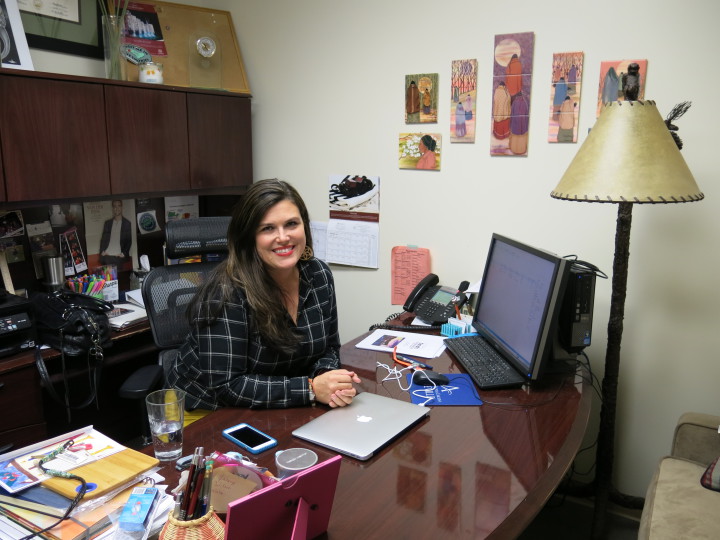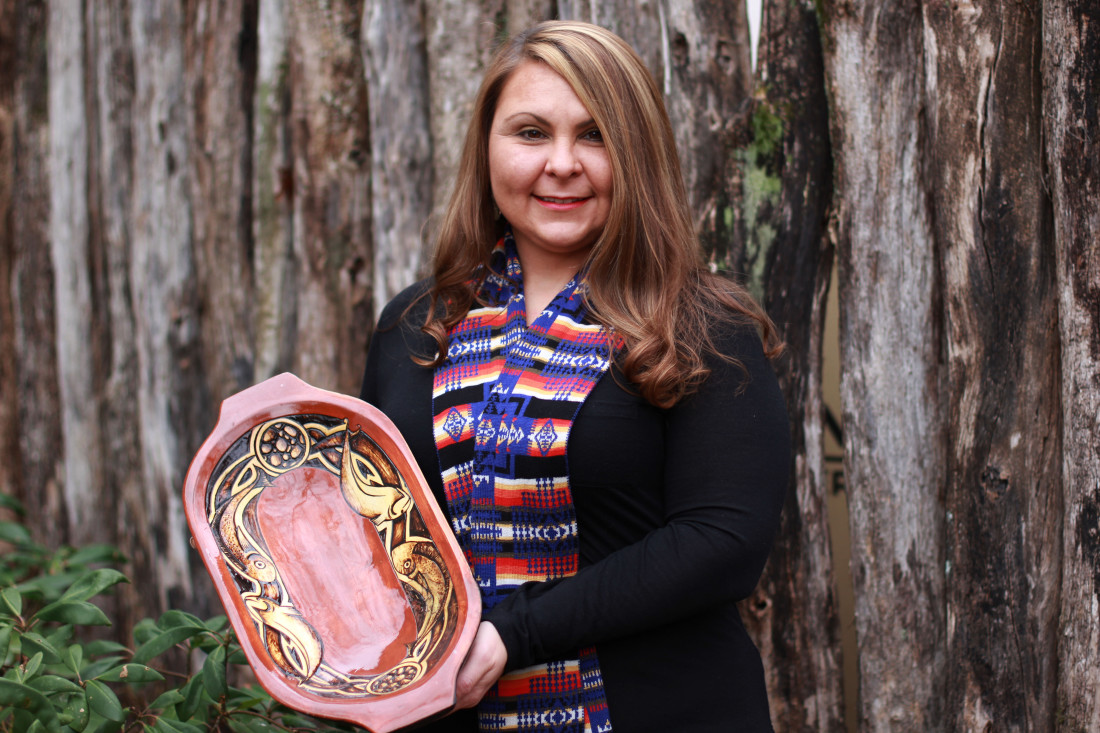There’s a cultural amnesia about what it means to be Native American, says Cherokee woodcarver Christy Long. “When you look at what people understand about a native, you get people who only understand natives from [a] romantic point of view.”
Such misconceptions mean tourists to Cherokee seek headdresses and dreamcatchers — neither of which are native to the tribe. That doesn’t mean, however, that headdresses and dreamcatchers aren’t sold. “When you’re trying to make a living, you still have to look at those things that people will purchase, so that you can make money to feed your family,” says Long. “It’s [an] existential struggle for a native person.”
Cultural norms within the tribe itself represent another struggle within the arts community, according to Long. Many artists grapple with what it means to sell their work. Are they doing it for personal recognition and gain, or for the good of the community? “In the non-native world, making a name for yourself is a valuable thing,” says Long. “Coming from Cherokee, it’s not something that’s heralded or appreciated.”
Still, some artists in Cherokee are looking into ways to do just that. The preservation of heritage and tradition remain the driving force behind the work, but many in the area have an interest in seeing their designs go beyond the mountains of Western North Carolina. Through their artwork, they wish to represent and distinguish the Eastern Band of Cherokee Indians from the generic, misappropriated and romanticized version of the native. They also view wider reception of their work as a way to honor and celebrate a past that continues to shape their present-day craft.
Through the generations

CARRYING ON TRADITION: Basketmaker Faye Junaluska stands before her mother’s works, on display inside the Permanent Collection Gallery of the Qualla Arts and Crafts Mutual Inc. Photo by Thomas Calder
Faye Junaluska was 20 years old before she attempted her first handmade basket. She spent her youth watching her mother fell trees, peel bark and dye splits in order to weave both decorative and functional designs. Rather than inspire baskets of her own, this early exposure created resistance. On occasion, her mother would ask if Junaluska wanted to learn, but when she was a child and teen, the process looked tedious.
Now in her late 50s, Junaluska laughs at her early refusal. “I didn’t realize that’s what put food on the table and a little bit of clothes on my back,” she says. Only after Junaluska became a parent did she seek out instruction. She remembers proudly proclaiming herself a basketmaker after completing her first design. Her mother was quick to point out that Junaluska had only woven a basket. She had not felled a tree, peeled its bark or dyed its splits. She still had a way to go.
Now, 38 years later, Junaluska has earned the title. Seated inside the Permanent Collection Gallery of the Qualla Arts and Crafts Mutual in Cherokee, she is surrounded by the baskets of her predecessors, including the works of Agnes L. Welch, her mother. She notes that it goes even further back in her family. “Our grandmother made them,” she says. “Our great-grandmother made them. … It’s important. … I’m preserving that task.”
Contemporary and traditional
Formed in 1946, Qualla Arts and Crafts Mutual is the nation’s oldest Native American cooperative. Since its opening, it has been one of the leading locations in Cherokee for artists to sell their work. “Quality has always been on the front burner,” says the co-op’s manager, Vicki Cruz.
Qualla Arts focuses on traditional works. Baskets are made from white oak, river cane and honeysuckle. Black walnut and native bloodroot are among the natural dyes used. The pottery, meanwhile, is still fired over an open flame.
Cruz notes, however, that some of the younger artists are incorporating more contemporary approaches and designs into their craft. Long, for example, uses a laser engraver to imprint traditional Cherokee designs on her work. Some artists capture ancient traditions, such as stickball, through the more modern forms of drawing and print.
The internet, Cruz adds, has offered these younger artists a broader audience. “That’s why I’m so happy the Sequoyah Fund is doing what they’re doing,” she says of the independent, nonprofit Native American community development financial institution based in Cherokee. “They’re helping the artists with their bios and promoting the contemporary arts.”
Reaching out
In 2013, the Sequoyah Fund offered a training course for businesses. “The only people who showed up were artists,” says Hope Huskey, the organization’s associate director. “We decided we’d start looking into art programs and how to develop art as a business.”

As a result, Sequoyah Fund partnered with ONABEN (an Oregon-based nonprofit that encourages the development of the private sector within native communities), to create Authentically Cherokee. Its mission is to celebrate and preserve Cherokee culture in a contemporary way.
Huskey says she works closely with 25 local artists, estimating there are an additional 25 who take part in programs offered by the organization. The Sequoyah Fund assists in marketing Authentically Cherokee artists, running its website, managing its social media, offering additional free business courses and shipping out orders. There is no charge for its services or classes beyond a 5 percent commission fee.
The organization is actively working with these artists to get their pieces out to a larger audience. The artists “don’t realize the uniqueness of what they can do outside of this community,” says Huskey. “A lot of times there’s a lack of self-confidence, and, in general, we [the Cherokee community at large] don’t do a great job of elevating the artists to where they need to be.”
In addition, Huskey notes the inner conflict that several of the makers continue to struggle with. “There is a little bit of a conversation about what we are selling,” she says. “Are we selling our culture by giving this to people? And by giving this to people, are we giving away a part of something that is sacred to our community?”
Keeping the culture alive

At Cherokee High School, Josh Adams teaches woodcarving. A member of the tribe, he says it took him moving to Sante Fe, N.M., to break away from this former mindset of guilt and self-doubt. Adams returned to Cherokee in 2013. The award-winning artist says part of his goal as a teacher is to help students see that art isn’t simply something to fall back on. It can be a career — one that doesn’t have to compromise a tribe member’s integrity.
“There are some masks I carve that I wouldn’t carve to sell,” Adams says. “I think it’s a fine line to walk, and you have to teach [students] both sides of that. … They should be carving to preserve culture and to preserve heritage, but also, at the same time, if you’re good enough, you should be carving to make a living out of it. That’s something we constantly talk about.”
In discussing the state of the arts in Cherokee, visual artist Preston Bark exemplifies both the struggle within the community and the resolution required to grow as an artist. As a member of the Qualla Arts co-op and Authentically Cherokee, he understands the value of bringing Cherokee art to a broader audience. “It’s about keeping the culture alive,” he says.
Yet there remains ambivalence about what that broader audience means in relation to both the community and the artist. “It’s not all about making money and making a living,” Bark says.
Bark reflects on the greater, collective good. “It’s about keeping the art alive, so we don’t lose our identity,” he says. “If we lose it, then we’re nobody. We’re just another group of people living in a small town in North Carolina.”




Before you comment
The comments section is here to provide a platform for civil dialogue on the issues we face together as a local community. Xpress is committed to offering this platform for all voices, but when the tone of the discussion gets nasty or strays off topic, we believe many people choose not to participate. Xpress editors are determined to moderate comments to ensure a constructive interchange is maintained. All comments judged not to be in keeping with the spirit of civil discourse will be removed and repeat violators will be banned. See here for our terms of service. Thank you for being part of this effort to promote respectful discussion.